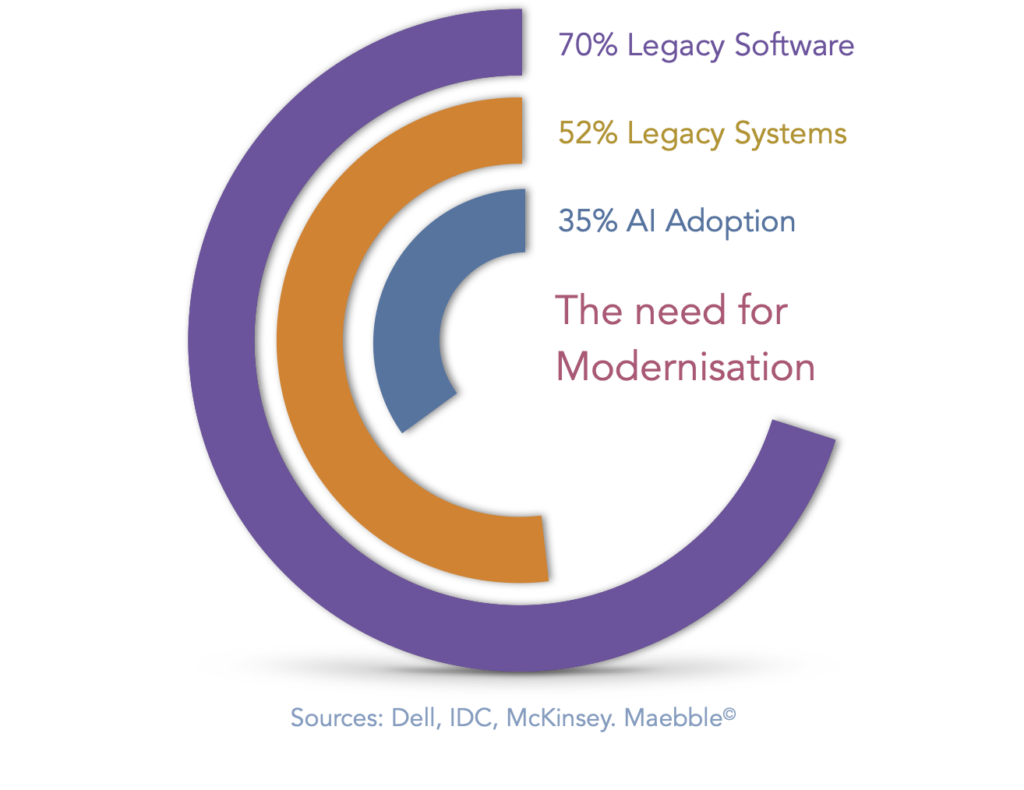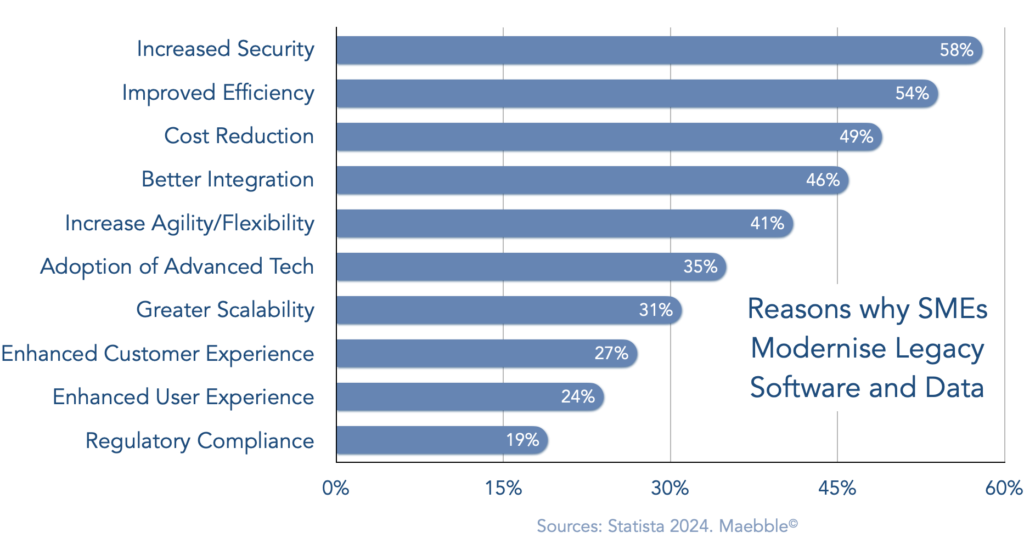
Small and Medium-sized Enterprises (SMEs) are confronted with the pressing need to modernise their legacy software and systems as the business landscape around them is evolving ever faster. This imperative, however, is no longer merely about catching up with the times; it’s about unlocking a wealth of opportunities for growth, innovation, and getting ahead of the competition.
In this article, we delve into the transformative journey of modernisation and the additional benefits that can be harnessed through the adoption of custom-made software solutions to integrate modernised legacy software into current and future applications.

The Imperative for Modernisation
- Legacy Software Constraints
Legacy software, once the cornerstone of SME operations, now poses significant limitations. Outdated technology, complex architectures, maintainability difficulties, and scalability challenges inhibit agility and innovation. Legacy modernisation is essential to overcome these constraints and propel SMEs towards success in the digital era.
- Competitive Advantage
Modernised software systems provide SMEs with a competitive edge in today’s fast-paced market. By leveraging cutting-edge technologies and streamlined processes, SMEs can differentiate themselves from competitors, capture new opportunities, (re)connect with customers, and enhance their market positioning.
- Future-Proofing
The pace of technological advancement requires SMEs to future-proofing their IT landscape. Modernised legacy software enable SMEs to adapt quickly to emerging trends and customer expectations, scale their operations, and stay ahead of the curve in an increasingly digital-centric business environment.

Benefits of Custom Software Solutions
- Seamless Integration
Adopting custom-made software solutions allows SMEs to seamlessly integrate modernised software into their existing and future applications. This integration streamlines workflows, enhances data interoperability, and eliminates silos, fostering a more cohesive and efficient operational ecosystem.
- Tailored Functionality
Custom solutions offer SMEs the flexibility to tailor software functionality to their specific business needs. Whether it’s automating manual processes, optimising supply chain management, or enhancing customer engagement, custom solutions empower SMEs to optimize their operations and drive value creation.
- Scalability and Adaptability
Tailor-made applications are inherently scalable and adaptable, aligning perfectly with SMEs’ evolving business requirements. As SMEs grow and diversify, custom solutions can easily accommodate increasing transactions, expanding user bases, and changing market dynamics, ensuring long-term viability and competitiveness.
- Enhanced User Experience
Custom-build applications prioritise user experience, delivering intuitive interfaces and seamless workflows that enhance productivity and user satisfaction. By placing users at the center of the design process, SMEs can drive user adoption, reduce training overheads, and improve overall employee engagement.
The ultimate benefit: Reduced Total Cost of Ownership (TCO)
Modernising legacy software and integrating it into current applications with custom solutions brings about significant cost savings for SMEs. By refactoring and reviving business knowledge stored in legacy systems, building tailor-made applications in current languages and databases, the maintenance costs associated with legacy systems are substantially minimised. Furthermore, the seamless integration of modernised systems into existing applications reduces the need for costly infrastructure upgrades or company-wide introduction of enterprise software, mitigating the risk of operational disruptions.
Hence, this reduction in TCO is achieved both in capital expenditures (Capex) and operational expenditures (Opex), resulting in improved cost-efficiency and resource optimisation for SMEs. Ultimately, the lower TCO enables SMEs to allocate resources more strategically, invest in innovation, and drive sustainable growth in the long term.
Conclusion: Unleashing the Full Potential of SMEs
Modernisation of legacy software is not just about catching up; it’s a strategic imperative and opportunity for SMEs to excel in today’s digital landscape. By embracing custom-made software solutions to integrate modernised legacy applications into their operations, SMEs can unlock a myriad of opportunities for growth, innovation, and competitiveness. From enhancing productivity and user experience to ensuring scalability and adaptability, the benefits are manifold.
Moreover, reductions in TCO, effecting both Capex and Opex, due to lower maintenance costs and savings from integrating modernised legacy software into current applications, further solidifies the case for modernisation. Now is the time for SMEs to seize the moment, harness the power of technology, and embark on a transformative journey towards a brighter, more prosperous future.
